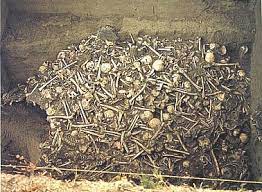Much of this is taken on faith because 2,000 years after most of the world, the early immigrants to the Americas still hadn't learned to read and write. That leaves what scientists call just-so stories but what humanities academics lovingly embrace as oral tradition. Any parent who has asked a child to go ask another parent a question knows how quickly that can go awry but we are supposed to b
In 1820s Last of The Mohicans, the title is derived because even by the time of the French and Indian War there were no pure women for the nephew of Uncas to marry - in the eyes of the tribe. But there hadn't been for centuries.
Nor were they in harmony with nature. All of those pierced skulls took place during times of drought. Rather than go to where water was, they took it from those nearby who had it.

Bodies from the Crow Creek Massacre of 1325.
"Of all the North American Indian tribes, the seventeenth-century Iroquois are the most renowned for their cruelty towards other human beings. Scholars know that they ruthlessly tortured war prisoners and that they were cannibals; in the Algonquin tongue the word Mohawk actually means "flesh-eater." There is even a story that the Indians in neighboring Iroquois territory would flee their homes upon sight of just a small band of Mohawks. Ironically, the Iroquois were not alone in these practices. There is ample evidence that most, if not all, of the Indians of northeastern America engaged in cannibalism and torture—there is documentation of the Huron, Neutral, and Algonquin tribes each exhibiting the same behavior. This paper will examine these atrocities, search through several possible explanations, and ultimately reveal that the practices of cannibalism and torture in the Iroquois were actually related.
...
It is also important to establish that the practices of the Iroquois were more than the exaggeration and hearsay of excitable Frenchmen. The Iroquois surely performed torture upon war captives; many European settlers viewed first-hand the mutilated body-parts of war captives. However, there has been some doubt in the current century that cannibalism was really practiced by the Iroquois. Anthropologist W. Arens proposed in 1979 that there were no first-hand accounts of flesh eating among the Native Americans, and thus no solid proof for cannibalism. This controversial view has been refuted since, for there is indeed ample evidence in The Jesuit Relations and Allied Documents alone to prove Arens’s thesis wrong. With this assertion in mind, it is now possible to inquire why the Native Americans performed these appalling acts.
...
"As previously mentioned, the Iroquois were not alone in this practice, as various accounts describe the Winnebagos, Huron, and other French-sympathizing Indians partaking in feasts of human flesh. In the aforementioned Champlain account, the Algonquins, Montagnais, and Etechemins did not actually eat the Iroquois captive’s flesh, but rather forced the other captives to eat his heart. Though this makes a case against cannibalistic practice, another account one year later tells of these same three tribes taking a quartered body home to be eaten. In another part of the country, a Neutral brave is recorded in Relation des Hurons saying to the Jesuit Father Brebeuf and his company, "[I’ve had] enough of the dark-colored flesh of our enemies…I wish to know the taste of white meat, and I will eat yours." In the same set of accounts the Jesuits chastise the Hurons to "eat no human flesh" so that they could be good Catholics.
"There was also a form of cannibalism that occurred in another near-by tribe, which is now studied by psychologists and anthropologists. Occasionally members of the Algonquin tribe suffered from a particular psychosis in which the Indian believed himself or herself "possessed" by the Wendigo, an Indian demon. The affected Native American would crave human flesh and kill people in order to eat their bodies. Anthropologist, however, diagnose this as a strange mental disorder, and obviously not applicable to the Iroquois practice in any way. Nor has there been, from a historical viewpoint, any mention of the Wendigo in association with the Iroquois. It is also true that the Iroquois never ate the flesh of their own people. Though Wendigo Psychosis has no bearing to the Iroquois, examining another flesh-eating culture may provide a clue to their abominable acts.
"The Aztecs are a perhaps the best known nation of people besides the Iroquois who possessed cannibalistic practices. High priests ritually sacrificed victims to their god Uitzilopochtli by removing the captive’s heart. When they had finished with the body they threw it down the steps of the sacred pyramid where it was taken and eaten by the citizens. Despite the association with religion, contemporary anthropologists have come to the conclusion that the act of cannibalism had less to do with the sacrificial ceremony and more with improper nutrition. Their practice results from a protein-deficient diet in which human beings are the only real source of meat. While there are instances of Native Americans resorting to cannibalism in very hard times, these northeastern Indians generally had no lack of meat, and since their cannibalism was limited to war prisoners, this reason is unlikely. This is not to say that cannibalism was never practiced for food by the Iroquois or their neighbors, just that it was definitely not the primary practice in the present context."



Comments